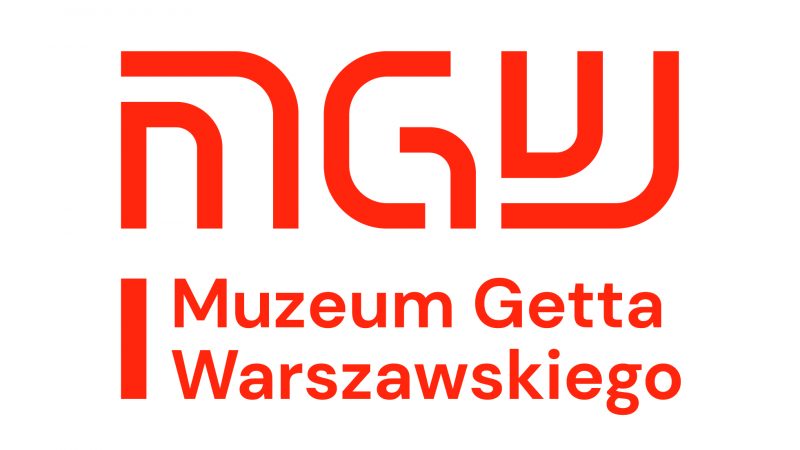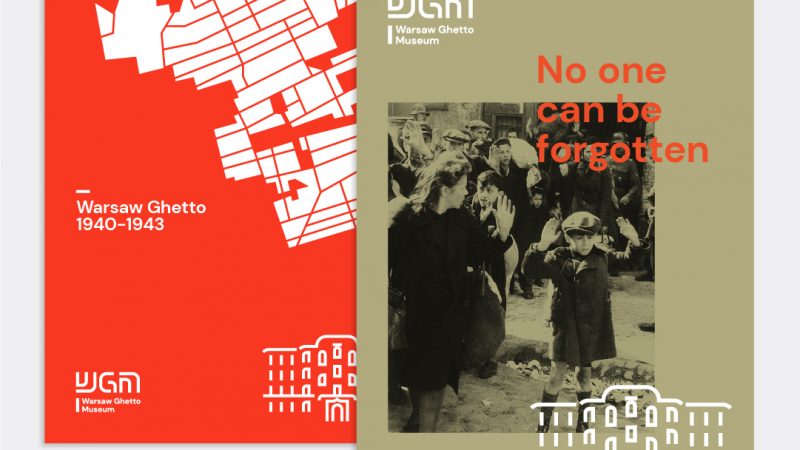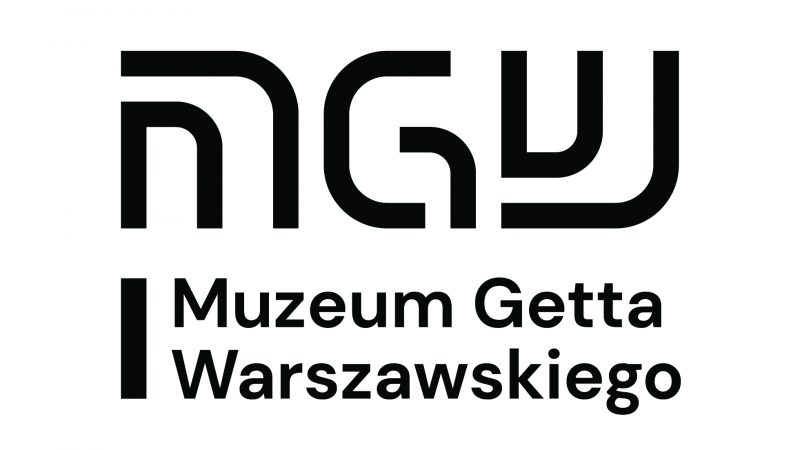White, red, black, stone brown and light blue – premiere of Memory Identification (Memobook)
We would like to present you with a new concept of visual identification of the Warsaw Ghetto Museum, selected by an international graphic competition organised jointly with the Polish Association of Applied Graphic Designers. The authors of the winning concept are designers from the Lithuanian studio – DADADA.
23 April 2020
The competition for visual identification of the Warsaw Ghetto Museum, organised in cooperation with the Polish Association of Applied Graphic Designers, was announced in September 2019. In the first stage, 216 applications were received.
“From the very beginning, this competition aroused great interest – designers from all over the world submitted their portfolios. 6 studios/designers – including three from Poland – were qualified for the second, paid stage. During the jury meeting, the design of the DADA studio gained a clear majority of votes,” says Lena Mitkowa, member of the management board of the Polish Association of Applied Graphic Designers, creative-in-chief in Lenivastudio.
Three studios from Poland are: Futu, Redkroft, The Codeine. Moreover, the designers from the Czech-British studio Little Greta, the Lithuanian studio DADADA and the Italian designer Francesco Ciampa were qualified for the second stage. The finalists prepared works in the form of specific visual identification concepts to be evaluated by the competition jury. 11 designs were submitted.
The winning work was selected by the international jury composed of: Małgorzata Naimska – Deputy Director of the Culture Dpt. of the City of Warsaw; Barbara Schabowska – Director of the Adam Mickiewicz Institute; Philippe Boulakia, lecturer at the Bezalel Academy of Arts and Design in Jerusalem; Prof Sławomir Kosmynka from the Strzemiński Academy of Fine Arts in Łódź and Albert Stankowski – Director of the Warsaw Ghetto Museum.
The winning concept of the Lithuanian DADADA Studio translates the mission of the Warsaw Ghetto Museum from the official language into the language of emotions, referring to individual memory. The authors are supported by the idea of commemorating specific people, as expressed in the slogan “No one can be forgotten”. In addition to the regular logotype, based on the name of the institution, an algorithm has been designed that enables almost limitless possibilities of creating logos based on specific, historical names.
Visual identification is much more than a logo, it is the context and language of forms, colours and typefaces, which form a well-thought-out key visual characteristic of the brand – in this case of the Warsaw Ghetto Museum.
Identification colours are assigned with associations and meanings: red (terror), stone brown (history), light blue (hope).
The DADADA studio designed a unique typeface inspired by Hebrew lettering, called “Memotype”. Its characters are used only in the logotype signet.
The logotype signet always consists of initials, in its basic (institutional) form it is an abbreviation of the name of the Warsaw Ghetto Museum, and in versions commemorating victims and ghetto survivors – the initial letters of their first names and surnames. An integral part of the logotype is the full name of the Museum, and in variants commemorating people, also their full names.
The visual code determines the design of the whole family of graphic materials that identify the Warsaw Ghetto Museum: small format prints, such as business cards, letterheads, envelopes, leaflets (also in electronic versions): folders, posters and any materials to be used online, which most often reach the mass audience on the Internet (social media).
“The economical and well-thought-out graphic form is fully adequate to the importance of the topic. The concept of identification proposed by the DADADA studio from Vilnius is part of the contemporary trend of generative graphics. It is progressive and dynamic. It makes people think. With its autonomous structure, it points to the values that create culture. It does not touch on the relationship with contemporary studies typical for corporations. Through the properly selected measures, it fits into the area of cultural memory,” explains graphic designer and lecturer of the Strzemiński Academy of Fine Arts in Łódź, Prof Sławomir Kosmynka and emphasises that by using the algorithm, the identification engages the recipient and activates one’s imagination.
Professor Filip Boulakia points out that the power of message lies in the changeable sign. The concept of recalling the names of people who, forced to live in the Warsaw Ghetto, tried to survive, and in many cases died, is a noble and respectful form of commemoration.
“The Lithuanian concept based on the principles of branding has broken all the rules of the “well-known” branding process. Instead of creating a rigid and monolithic design, which nowadays is a very common phenomenon in the world of museum culture, they created a concept that is constantly changing. There is no single logo, but thousands of different logos created to commemorate people who stayed in the Warsaw Ghetto and survived or died. The strength of this concept lies in the fact that it does not illustrate the horror with numbers or fancy symbols, but with the real names of people who experienced the life in the ghetto” says Prof Boulakia.
Małgorzata Naimska – Deputy Director of the Culture Dpt. of the City of Warsaw emphasises that the Warsaw Ghetto Museum is an exceptional institution on the map of European institutions, on the one hand closely connected with Warsaw and its difficult history, and on the other hand performing a mission which aims at commemorating all ghettos created by the Germans during World War II.
“Therefore, the visual identification of this institution should take its pro-social nature into account. Moreover, it must be understandable to people of many cultures and languages. The Lithuanian design met the criteria adopted by the jury to the greatest extent,” explains Małgorzata Naimska.
“I am impressed by the openness and courage of the decision-makers of the Warsaw Ghetto Museum – they decided to implement a design that is unique in many aspects. I am also overwhelmed by its intellectual maturity and sensitivity. The system is based on a concept that will allow the audience to better understand the essence of the museum and engage them from the first contact. In my understanding, it is this interdisciplinary, strategically developed approach that is the future of design. The design presents a holistic view of the task, from the essential layer, through the visual design itself, to the implementation and use of digital solutions” concludes Lena Mitkowa.
A post-competition exhibition presenting the finalists and all the designs submitted by them was to be held in the spring of 2020. Unfortunately, the extraordinary situation of epidemic has thwarted the plans. The inauguration date of the exhibition will be changed. We will inform you of the new date as soon as possible.
Miłka Skalska, press spokeswoman
Photo: WGM




